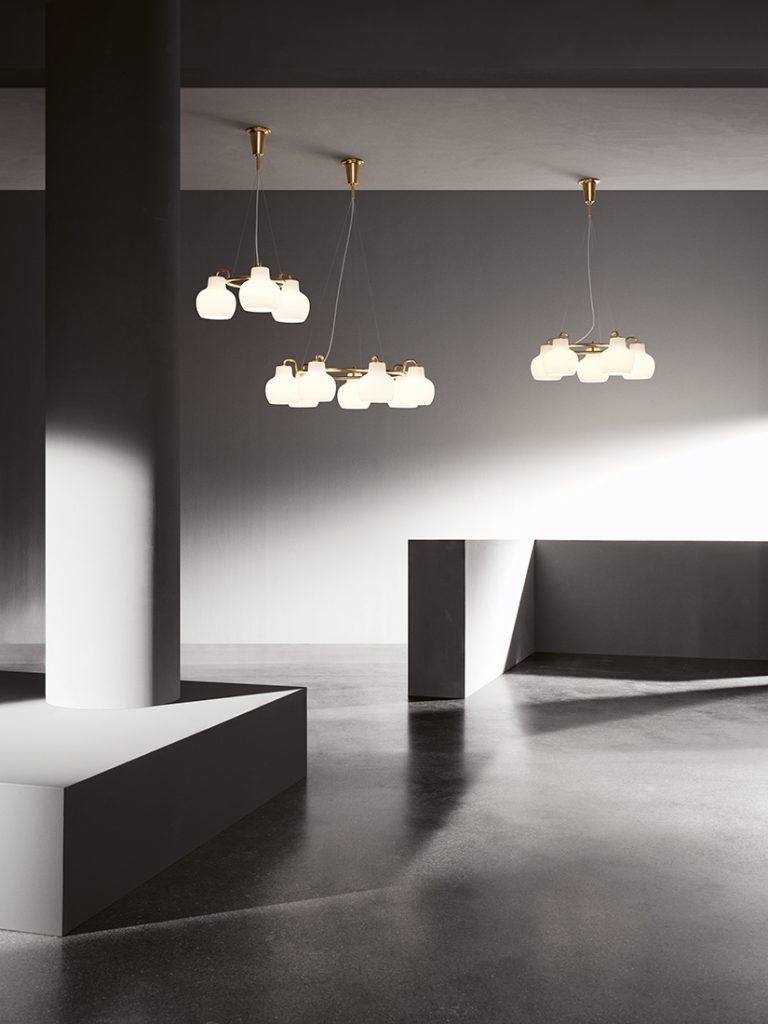Straddling tradition and modernity, Vilhelm Lauritzen designed the VL Ring Crown light in the 1940s with a keen eye for practicality and beauty. Now Louis Poulsen has re-issued the design classic for contemporary times.

In 1934 Vilhelm Lauritzen was invited to be a part of the team commissioned to design a new building for the Danish Broadcasting Corporation (known at the time as Statsradiofonien). At that time radio studios were an entirely new form of building. The first public news and entertainment broadcasts over radio had only been made in the USA in 1920, bringing the sounds of the world into the living room – and disrupting the pre-recorded formality of the phonograph with live human entertainment.
The shift within the sanctuary of the private domestic realm must have been felt intensely. “Like aviation and motoring, the radio represented new, modern technology, shortening distances between people and creating a totally new way of existing in the world,” writes Vilhelm Lauritzen Architects. And the design of the Danish Broadcasting Corporation building (Radiohuset) in Copenhagen picked up on this current with a purposefully modern and asymmetrical design.

The building, says Lauritzen’s studio, was given “a really rough ride” when its design was published. It was inaugurated in 1945 but it was not until 1994 that its significance was formally recognised with heritage listing. “Since then, all major conversions, renovations, and maintenance tasks have been subject to approval by the Danish Agency for Culture and Palaces,” describes Vilhelm Lauritzen Architects.
Alongside the architecture, Lauritzen also contributed lighting designs to Radiohuset, including the VL38 lamp. Wall lamp and pendant versions of Louis Poulsen’s VL Ring Crown were also installed within the mahogany-rich interior. Their white opal glass shades create striking outlines against the dark timber.

The young architect Finn Juhl was working for Lauritzen at the time. Soon after the completion of Radiohuset he incorporated the VL Ring Crown into an award-winning interior for the flagship store of Danish porcelain manufacturer, Bing & Grøndahl, in Copenhagen in 1947. This was the first time VL Ring Crown had been used in its multiple-shade format, which had in fact been designed at the same time as the wall lamp and single pendant versions.
Lauritzen received plenty of orders for the VL Ring Crown. Perhaps this is owing to its fusion of a satisfyingly simple organic form with deep consideration for practicality. Imagining the VL Ring Crown in the context of the Radiohuset – which had so shaken the community with its modernity – it makes sense that Lauritzen sought a lighting form that neither revolutionised in terms of form nor bowed entirely to historic precedent.

VL Ring Crown has a distinctive bulbous shape that emerges from a cylindrical neck with glossy white triple-layered, mouth-blown opal glass offering warm light and soft illumination. It is anti-glare, of course, in line with the Louis Poulsen way. Its untreated polished-brass hanging structure supports three, five or seven shades. Every part of the design bears a purpose.
In a 1953 article in Louis Poulsen’s magazine, NYT, Lauritzen described his straightforward intentions with VL Ring Crown: “It should be easy to dust, not collect dirt at the bottom, not break in one go if damaged, be easy to change the bulb, be as glare-free as possible (without dimming) and be available for downward lighting and for evenly rounded light as needed. And it should look neat.”

Practical, glare-free and neat, VL Ring Crown brings not only a distinctive look to contemporary interiors, but also gentle light that rings true to the Louis Poulsen emphasis on human experience – no matter the spatial context.
A searchable and comprehensive guide for specifying leading products and their suppliers
Keep up to date with the latest and greatest from our industry BFF's!

BLANCO launches their latest finish for a sleek kitchen feel.

Vert, an innovative demountable pergola designed for urban greening, is reshaping the way we think about sustainability in urban architecture.

Within the intimate confines of compact living, where space is at a premium, efficiency is critical and dining out often trumps home cooking, Gaggenau’s 400 Series Culinary Drawer proves that limited space can, in fact, unlock unlimited culinary possibilities.

In this candid interview, the culinary mastermind behind Singapore’s Nouri and Appetite talks about food as an act of human connection that transcends borders and accolades, the crucial role of technology in preserving its unifying power, and finding a kindred spirit in Gaggenau’s reverence for tradition and relentless pursuit of innovation.

Architectus has designed new interiors for Allianz with an astute understanding of the modern workplace, where architecture, nature and technology converge to create an agile environment.

Fermob, the renowned French outdoor furniture brand, has inaugurated its first showroom in Sydney, solidifying its presence in the Australian market.
The internet never sleeps! Here's the stuff you might have missed

Herman Miller’s Bay Work Pod isn’t just about creating a cosy nook amidst the expanse of an open office – it’s about fostering a genuinely inclusive environment where everyone feels empowered to do their best work. Could this be the pod that finally gets it right?

Fluid and flowing, Cocoon is a school that, through its architectural form, enhances the day-to-day rituals of learning and elevates the experience for the very young.